It looks like you're using an Ad Blocker.
Please white-list or disable AboveTopSecret.com in your ad-blocking tool.
Thank you.
Some features of ATS will be disabled while you continue to use an ad-blocker.
13
share:
That ancient Egyptian myth refered to the concept of 'The Double Door' of the heavens, associate with the horizon, is non-contentious and widely held,
so i needn't prove or referance the basic concept here, what i will demonstrate is the basic science of how the horizon was sub-divided in ancient
Egypt, how the system of Decans and 'star-clocks' related to this, how funerary architecture and iconography was considered in conjunction to this,
then look at the specifics involved with passing through the Double Doors themselves, and thence into the Heavens...
The basic model for how the horizon was seen as divided in ancient Egypt is highly comparable to the Sumerian model i outlined here;
Sumerian Stargates
It would appear the most likely that the Egyptians developed their model from the Sumerians, who divided the longitudinal/latitudinal horizons into 36 sub-sectors, were the months were associate with the longitudinal horizon, the latitudinal divided into 3 main bands or pathways across which the planets and stars were tracked, each sub-divided into 12 sectors.
members.westnet.com.au...
For the Egyptians i propose a slight modification, the latitudinal divided into four main bands each of 9 sub-sectors, the reason for this being that in Egypt the solstice angle was at around 27 to 28 degrees declination from due East, thus the Summer solstice at circa +27 degrees declination for Giza, with the winter solstice at -27 degrees declination, very fortuitious for a sub-division by 36.
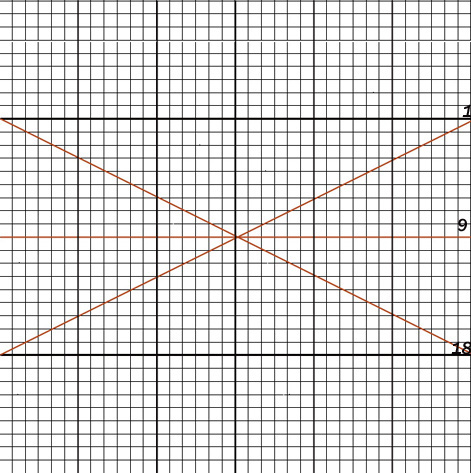
In the diagram above, the number 1 indicates the Summer Solstice point, the number 18 the winter Solstice. The reason i have indicated those numbers is that the ecliptic plane would progress from point 1 at the Summer solstice to point 18 the Winter Solstice, over six months, and then returnthe subsequent six months.
Thus those 18 points would correspond as the sighting referance for the Egyptian 36 subdivisions of the ecliptic plane, the Decans. Below is the link to an excellent paper discussing what was involved with the Decanal system and associate 'Star Clocks', and the available evidence.
Decanal Star Clocks
As the paper in summary suggests, the current accepted understanding falls short, this is largely due to the consideration that the Decans weren't directly along the ecliptic plane, but involved such stars and constellations as Sirius and Orion South of it, again such a 'system' simply isn't practical.
My proposal is that the sectors of the ecliptic plane were observed at their correspondant rising points, were each of the 18 sub-divisions equates with circa 10 days, a decade, and thus a Decan. The observed year begining at the Summer Solstice, with the 5 inter-calary days taken into account.
The longitudinal months would be direclty comparative to the Sumerian system, It can be noted as given that 6 signs of the zodiac will always be beneath the horizon, 6 above, as they transfer through the seasons/year, the diagram only needs 6 subdivisions for longitude, where the first month will translate to the 7th month, in the same manner that the ecliptic plane subdivision into 18 takes into account the reversal in direction for the second half of year.
What the system provides then, is that from start of year each decan is observed rising over ten days at each of the 18 (36) points on the latitudinal horizon, and the progression through the months will be correspondant over the 36 longitudinal sectors. In terms of the star clocks, these would have been in terms of x/y co-ordinates for auspicious stars associate with the time of death, taking into account the hours for relative ascension of the noted Heavenly body, thus a latitudinal Decan co-ordinate correspondant to a month co-ordinate.
So that's the basic and perhaps seemingly boring theoretical model, but the one Egyptology should adopt sooner rather than later. With it one can now move on to how this science may have been employed in funerary architecture and mythology, primarily through a study of the tomb of Unas;
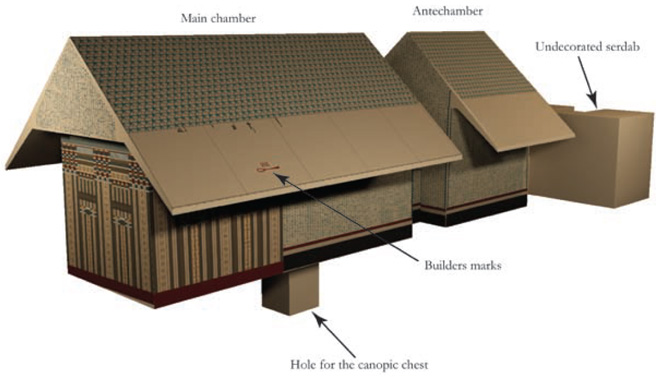
One observes that the burial chamber was essentialy a 2x1 rectangle, the reason for this being as i noted above in connection with only 6 months need be marked across the longitudinal sectors, as half the ecliptic plane is ever in the underworld, well the same here, the basic model for the underworld is the square and the world above the square, so here one simply sees the Under and Above realms together, albeit with their function demarcated.
The Akhet chamber is square, the concern here only in coming forth by day, into the above realm, and here the doorway on the East-West axis is seen to correlate to the solstice angle subdivision, were 36 lines of spells set out across the wall are subdivided
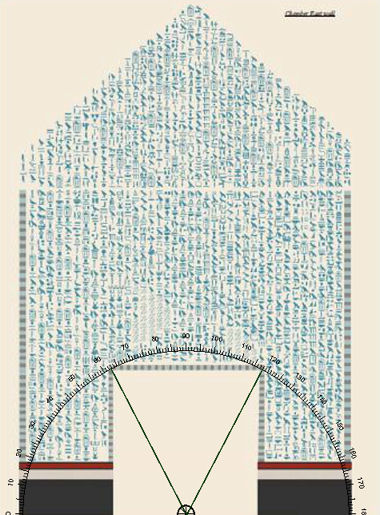
The chamber is based on the science of the horizon, the 36 subdivisions with place specific spells, the opening of the solstice angle, and the ceiling angle takes into account that stars rising due East achieve the highest ascension, this becoming progressively less toward the North and South.
In the burial chamber itself on the Western wall is seen what is known as 'The Palace Facade' design,
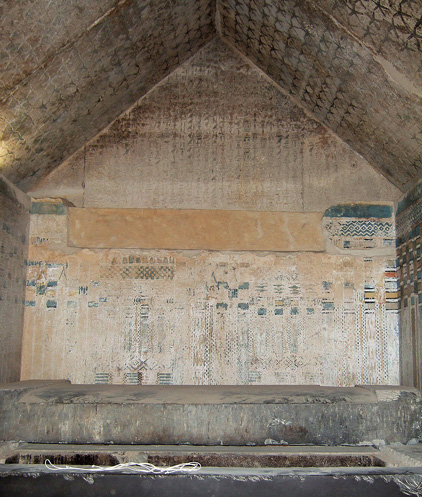
investigating this for sub-division into 36 sectors, one observes;
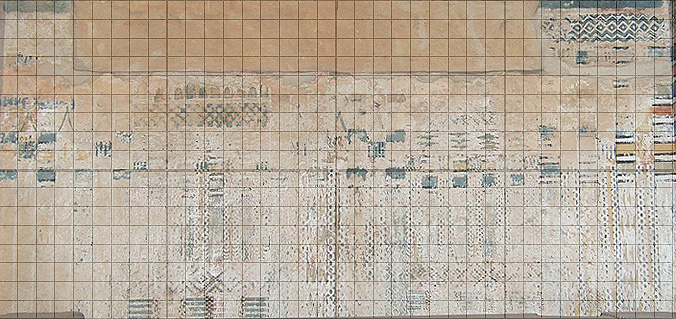
Taking into account photographic fore-shortening, lazy artists, rudimentary equipment, a reasonable correlation to the design having a basic sub-division into 36 sectors across the horizontaland perhaps that sub-divided furthur into 72.
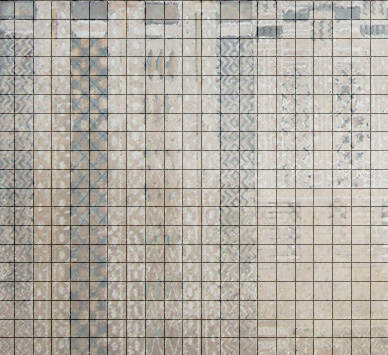
The next consideration is the placement of the actual doors of the 'Palace Facade' relative to the horizon, those in the coffin section of the burial chamber are seen thus;

It can be seen that measured from the centre of the coffin half of the chamber, the angle for the centre of these doors will be in terms of division into 1/16th sectors of a circle, or 22.5 degree sectors.
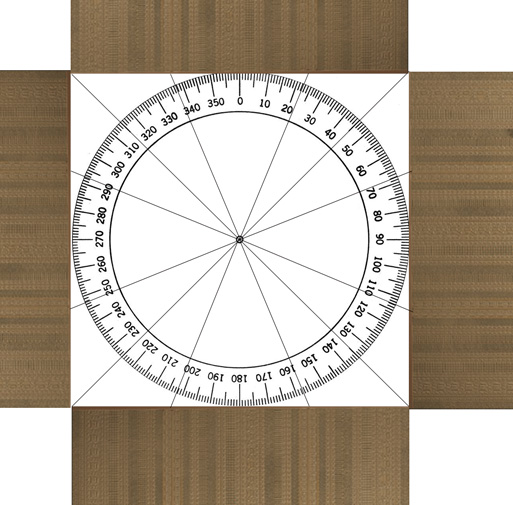
Looking at how this relates to the Summer solstice angle, seen here marked 'red', then this will correspond to the outer door frame, whilst the Northernmost/Southernmost moonrise points will correspond to the outer dimension of the overall portico.
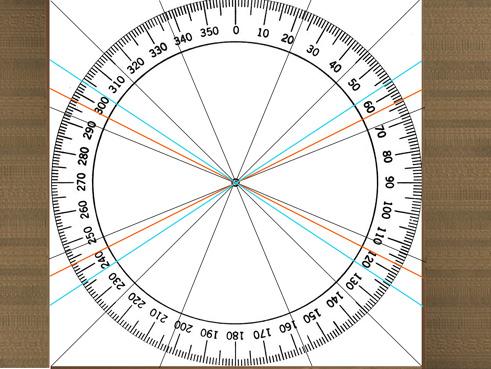
Perhaps surprisingly then the central entry point of the Heavenly Doors upon the horizon is located around 4.5 degrees, or 1/80th of a circle, away from the solstice points. In terms of time/distance/angle this will correspond to 15 days before or after the solstice, when the sun rises at the central point of these doors, and it will take several days to cover 1 degree or 1/360th of the circle.(circa 3.3 days per degree were 182 days divided by angle between solstices of 54 degrees)
So to look at any significance attached to this day, rising point upon the horizon, the Egyptian Festival periodics need to be consulted, to be continued....
www.digitalegypt.ucl.ac.uk...
The basic model for how the horizon was seen as divided in ancient Egypt is highly comparable to the Sumerian model i outlined here;
Sumerian Stargates
It would appear the most likely that the Egyptians developed their model from the Sumerians, who divided the longitudinal/latitudinal horizons into 36 sub-sectors, were the months were associate with the longitudinal horizon, the latitudinal divided into 3 main bands or pathways across which the planets and stars were tracked, each sub-divided into 12 sectors.
members.westnet.com.au...
For the Egyptians i propose a slight modification, the latitudinal divided into four main bands each of 9 sub-sectors, the reason for this being that in Egypt the solstice angle was at around 27 to 28 degrees declination from due East, thus the Summer solstice at circa +27 degrees declination for Giza, with the winter solstice at -27 degrees declination, very fortuitious for a sub-division by 36.

In the diagram above, the number 1 indicates the Summer Solstice point, the number 18 the winter Solstice. The reason i have indicated those numbers is that the ecliptic plane would progress from point 1 at the Summer solstice to point 18 the Winter Solstice, over six months, and then returnthe subsequent six months.
Thus those 18 points would correspond as the sighting referance for the Egyptian 36 subdivisions of the ecliptic plane, the Decans. Below is the link to an excellent paper discussing what was involved with the Decanal system and associate 'Star Clocks', and the available evidence.
Decanal Star Clocks
As the paper in summary suggests, the current accepted understanding falls short, this is largely due to the consideration that the Decans weren't directly along the ecliptic plane, but involved such stars and constellations as Sirius and Orion South of it, again such a 'system' simply isn't practical.
My proposal is that the sectors of the ecliptic plane were observed at their correspondant rising points, were each of the 18 sub-divisions equates with circa 10 days, a decade, and thus a Decan. The observed year begining at the Summer Solstice, with the 5 inter-calary days taken into account.
The longitudinal months would be direclty comparative to the Sumerian system, It can be noted as given that 6 signs of the zodiac will always be beneath the horizon, 6 above, as they transfer through the seasons/year, the diagram only needs 6 subdivisions for longitude, where the first month will translate to the 7th month, in the same manner that the ecliptic plane subdivision into 18 takes into account the reversal in direction for the second half of year.
What the system provides then, is that from start of year each decan is observed rising over ten days at each of the 18 (36) points on the latitudinal horizon, and the progression through the months will be correspondant over the 36 longitudinal sectors. In terms of the star clocks, these would have been in terms of x/y co-ordinates for auspicious stars associate with the time of death, taking into account the hours for relative ascension of the noted Heavenly body, thus a latitudinal Decan co-ordinate correspondant to a month co-ordinate.
So that's the basic and perhaps seemingly boring theoretical model, but the one Egyptology should adopt sooner rather than later. With it one can now move on to how this science may have been employed in funerary architecture and mythology, primarily through a study of the tomb of Unas;

One observes that the burial chamber was essentialy a 2x1 rectangle, the reason for this being as i noted above in connection with only 6 months need be marked across the longitudinal sectors, as half the ecliptic plane is ever in the underworld, well the same here, the basic model for the underworld is the square and the world above the square, so here one simply sees the Under and Above realms together, albeit with their function demarcated.
The Akhet chamber is square, the concern here only in coming forth by day, into the above realm, and here the doorway on the East-West axis is seen to correlate to the solstice angle subdivision, were 36 lines of spells set out across the wall are subdivided

The chamber is based on the science of the horizon, the 36 subdivisions with place specific spells, the opening of the solstice angle, and the ceiling angle takes into account that stars rising due East achieve the highest ascension, this becoming progressively less toward the North and South.
In the burial chamber itself on the Western wall is seen what is known as 'The Palace Facade' design,

investigating this for sub-division into 36 sectors, one observes;

Taking into account photographic fore-shortening, lazy artists, rudimentary equipment, a reasonable correlation to the design having a basic sub-division into 36 sectors across the horizontaland perhaps that sub-divided furthur into 72.

The next consideration is the placement of the actual doors of the 'Palace Facade' relative to the horizon, those in the coffin section of the burial chamber are seen thus;

It can be seen that measured from the centre of the coffin half of the chamber, the angle for the centre of these doors will be in terms of division into 1/16th sectors of a circle, or 22.5 degree sectors.

Looking at how this relates to the Summer solstice angle, seen here marked 'red', then this will correspond to the outer door frame, whilst the Northernmost/Southernmost moonrise points will correspond to the outer dimension of the overall portico.

Perhaps surprisingly then the central entry point of the Heavenly Doors upon the horizon is located around 4.5 degrees, or 1/80th of a circle, away from the solstice points. In terms of time/distance/angle this will correspond to 15 days before or after the solstice, when the sun rises at the central point of these doors, and it will take several days to cover 1 degree or 1/360th of the circle.(circa 3.3 days per degree were 182 days divided by angle between solstices of 54 degrees)
So to look at any significance attached to this day, rising point upon the horizon, the Egyptian Festival periodics need to be consulted, to be continued....
www.digitalegypt.ucl.ac.uk...
edit on 28-5-2012 by Kantzveldt because: typo
To continue, it was seen that the central point of the Heavenly Doors would correspond to a rising point on the horizon some 15 days before or after
the Summer Solstice (or Winter), and that it would rise at that point for a little over three days, so to consult the Festivals,
day 15 offerings to Hapy and Amun to secure a good flood (known from Dynasty 19 rock inscriptions at Gebel el-Silsila)
day 17 eve of the Wag festival
day 18 Wag festival
day 19 Wag and Thoth festival, according to the great festival list in the temple for Ramesses III at Medinet Habu
These Festival periodics for the first month after the Summer solstice are highly interesting, with regards to entrance into the Heavens, the suggestion is that there was some sort of reconcilliation between a lunar calendar and the civil, the first full moon of the New Year probably being an aspect of these festivities;
The Wagy Festival involved turning the water into wine as it were;
Drunkard Magazine
An aspect of these festivities was of ensuring supplies for those that had passed into the afterlife.
In this connection there is also mention from the tomb of Unas of the tomb as a barrier'
This finds curious correspondance with what was reported by Plutarch regarding the cult of Osiris;
The 17th day then as a barrier, associate with the tomb to be overcome, and a hyperbolic equation involving this...
More generally, 16 and 18 represent solutions (x=4, y=4) and (x=3, y=6) of the hyperbolic equation
xy = 2x + 2y
which in modern terms has an infinity of solutions; Plutarch is saying that (x=4, y=4), (x=3, y=6), and (x=6, y=3) are the only integral solutions. To his positive solutions we would add today three more, at (x=0, y=0), (x=1, y=-2) and (x=-2, y=1): they are symmetrical to Plutarch's set with respect to the two asymptotes, and in terms of geometry represent one null and two imaginary rectangles. In theory, to find any others we are suddenly transported into the very difficult realm of Diophantine equations; but that these are the only five integral solutions can be seen instantly by inspecting the graph. Plutarch's square, and one of his two symmetrical rectangles, are shaded.
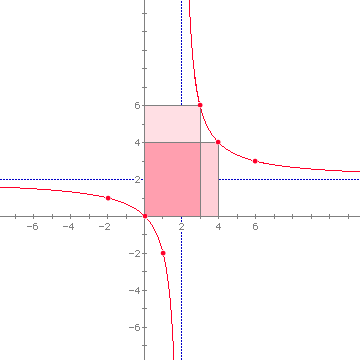
Plutarch-Isis and Osiris
This all seems wonderfully obscure, until perhaps one realises that the Christian Holy week conforms to the same numeric model and periodics, with the 17th day relating to the day in the tomb and the 18th the day of resurrection, as a side note.
www.perillos.com...
So we can assign our doorway located 1/80th of a circle away from the Summer Solstice to the cult of Osiris and the periodic of his Wagy festival, and indeed this will be confirmed by Canopic jars which show Osiris in conjunction with the Doorway of Heaven;
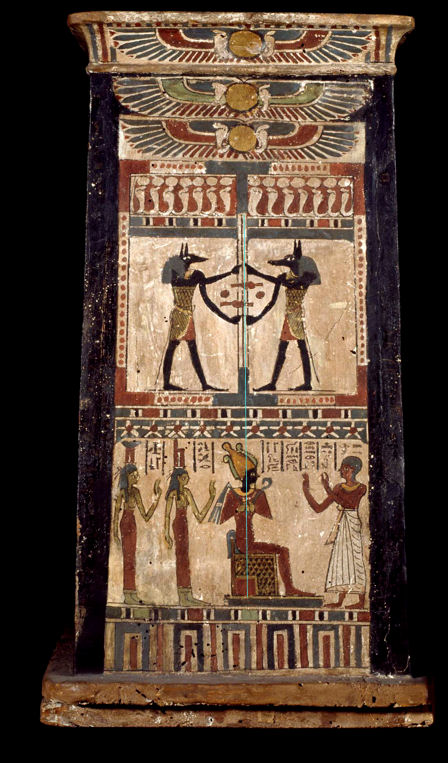
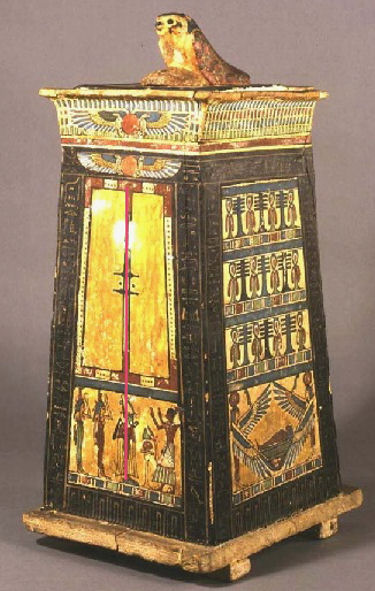
day 15 offerings to Hapy and Amun to secure a good flood (known from Dynasty 19 rock inscriptions at Gebel el-Silsila)
day 17 eve of the Wag festival
day 18 Wag festival
day 19 Wag and Thoth festival, according to the great festival list in the temple for Ramesses III at Medinet Habu
These Festival periodics for the first month after the Summer solstice are highly interesting, with regards to entrance into the Heavens, the suggestion is that there was some sort of reconcilliation between a lunar calendar and the civil, the first full moon of the New Year probably being an aspect of these festivities;
1994. Thoth and the Calendars. In A. Spalinger, ed., _Revolutions in Time: Studies in Ancient Egyptian Calendrics_: 45-60. Varia Aegyptiaca Supplement 6. San Antonio: Van Siclen Books.
[The author studies the reasons for the dating of the ubiquitous nationally based feast of Thoth, which is located in the Egyptian civil calendar one day following that of /wAgy/. After introductory remarks on Parker's Calendars and section on the historical lunar and civil calendars, the author turns to the chronological ordering of the first four feasts mentioned in the O.K. mastabas (/wpt-rnpt/ - /DHwtyt/ - /tpy rnpt/ - /wAgy/) and examines the special relation of the feast of Thoth, the moon god, to day 19 of the first civil calendar month (I akhet 19). Since /wAgy/ is generally understood to precede on I akhet 18, the data can be reconciled by assuming that /DHwtyt/ is civil year-based and the /wAgy/ referred to is the moveable one. At the end the author concludes that there is no need to posit three calendars in the historical period of Egypt: only a lunar and a civil are required.
Seventeen days after New Year's day, there was also the more somber feast of Wagy, which eventually became associated with the festival of Thoth on the nineteenth day of the year. This event was connected with the mortuary rituals of ancient Egypt and was celebrated by private individuals outside of official religious circles as well as within the precincts of the major temples in Egypt. Our first evidence of this celebration is from the 4th Dynasty, making it one of the oldest in ancient Egypt. The original date of the festival was set according to the lunar basis and this was never discarded. Hence, during the historical period, there were actually two separate Wagy feasts, one set according to the cycle of the moon and a later one firmly placed at day eighteen of the first civil month
The Wagy Festival involved turning the water into wine as it were;
Osiris also had the distinction of being the resident god of wine, and during the Wag-festival his name was expanded to “Lord of Wine in the Flood.” The festival celebrated Osiris’ death and rebirth, and coincided with the annual flooding of the mighty Nile. It also coincided with the reappearance in the nighttime sky of the star Sothis (Sirius) and heralded the arrival of the Egyptian new year. The circle of life — birth, death, rebirth — unbroken.
Long before western man had figured out a calendar, the Egyptians understood exactly how to bring in the new year. The Wag-festival can best be described as a three-day orgy of drunkenness and revelry. Clay amphorae (wine jars) were decanted by the thousands in and around the Temple of Osiris at Abydos and the party kicked off shortly before sunrise, when Sothis appeared in the heavens. It continued day and night with singing, dancing, poetry, and games, all set to the thunderous music of the flooding Nile.
Then, right at the height of the mayhem, it ended. Bang. Douse the torches and go on home.
Drunkard Magazine
Osiris was called "Lord of Drunkeness at the Wag-festival", which took place during the season of the grape harvest, shortly before the inundation. (Sigfrid Hoedel-Hoenes, Life and Death in Ancient Egypt, pg. 114) And wine was frequently offered to him, for instance, in the stela of Thutmose the doorkeeper, from the 18th Dynasty, we find that "water, a cool breeze and wine" are to be given to "the spirit of the inundation" and Horemheb offers Osiris wine in order to be granted the "gift of life, each day, like Ra". Vines could be depicted in funerary monuments associated with Osiris, the most famous example belonging to the 18th Dynasty Mayor of Thebes Sennefer, whose tomb was known for its stunningly beautiful depiction of a grape arbor as the "tombeau des vignes". The ceiling of his tomb is covered in vines and grapes painted with utmost care, reaching down into the shrine of Osiris within the burial chamber, as if originating from the realm of the God of life and vegetation.
An aspect of these festivities was of ensuring supplies for those that had passed into the afterlife.
"When you go forth to the sky, the sky shall give you birth like (sAH).........[Ho, Pepi Neferkare! Now I have bewailed you], now I have mourned you. I will not forget you. My heart will not tire of invoking you every day, with an endowed offering on every festival - on the first of the month, on the middle of the month, on the placing of the brazier, on the Thoth festival, on the Supply festival (wAg-festival), [on the meat-carving festival, on your yearly festivals]. You will be given birth at the first of your months and live as a god."
In this connection there is also mention from the tomb of Unas of the tomb as a barrier'
Awake. Turn youself about. So shout I. Unas, stand up and sit down to a thousand of bread, a thousand of beer, roast meat of your rib-joints from the slaughter house, and ith-bread from the Broad Hall. The god is provided with a god's offering, the King is provided with this bread of his. Come to your ba, Osiris, ba among the akhs, mighty in your places whom the Ennead protect in the Mansion of the Prince.Unas, raise yourself up to me, betake yourself to me, do not be far from me, for the tomb is your barrier against me. I give you the Eye of Horus
This finds curious correspondance with what was reported by Plutarch regarding the cult of Osiris;
The Egyptians have a legend that the end of Osiris's life came on the seventeenth of the month, on which day it is quite evident to the eye that the period of the full moon is over Because of this the Pythagoreans call this day "the Barrier," and utterly abominate this number. For the number seventeen, coming in between the square sixteen and the oblong rectangle eighteen, which, as it happens, are the only plane figures that have their perimeters equal their areas, bars them off from each other and disjoins them, and breaks up the ratio of eight to eight and an eighth by its division into unequal intervals
The 17th day then as a barrier, associate with the tomb to be overcome, and a hyperbolic equation involving this...
More generally, 16 and 18 represent solutions (x=4, y=4) and (x=3, y=6) of the hyperbolic equation
xy = 2x + 2y
which in modern terms has an infinity of solutions; Plutarch is saying that (x=4, y=4), (x=3, y=6), and (x=6, y=3) are the only integral solutions. To his positive solutions we would add today three more, at (x=0, y=0), (x=1, y=-2) and (x=-2, y=1): they are symmetrical to Plutarch's set with respect to the two asymptotes, and in terms of geometry represent one null and two imaginary rectangles. In theory, to find any others we are suddenly transported into the very difficult realm of Diophantine equations; but that these are the only five integral solutions can be seen instantly by inspecting the graph. Plutarch's square, and one of his two symmetrical rectangles, are shaded.

Plutarch-Isis and Osiris
This all seems wonderfully obscure, until perhaps one realises that the Christian Holy week conforms to the same numeric model and periodics, with the 17th day relating to the day in the tomb and the 18th the day of resurrection, as a side note.
The festival of Wagy was the day of the dead. The first traces of this cult date from the 4th Dynasty, which is also the dynasty of the Great Pyramid and its neighbours on the Gizeh plateau. On that day, the families came to the tombs of the deceased, with offerings, performing rituals, specifically “fumigations” – producing fumes – smoke.
We thus find ourselves reading about a death mass, where the souls are commemorated by their families – with the light of the torch perhaps reminding us of the light of the souls
www.perillos.com...
So we can assign our doorway located 1/80th of a circle away from the Summer Solstice to the cult of Osiris and the periodic of his Wagy festival, and indeed this will be confirmed by Canopic jars which show Osiris in conjunction with the Doorway of Heaven;


edit on 28-5-2012 by Kantzveldt because: Add
edit on 28-5-2012 by Kantzveldt because: Add
thanks dude...enjoyed it throughly.
like the theory.....
i think you should look at Mr A.Ibrahims work....its on sribd. c o m
called "real name of pyramids" i think....it seems to coincide with what your getting at....
keep up the good work....
peace
like the theory.....
i think you should look at Mr A.Ibrahims work....its on sribd. c o m
called "real name of pyramids" i think....it seems to coincide with what your getting at....
keep up the good work....
peace
reply to post by thePharaoh
Hi,
i think the main point of divergance there is that what i suggest requires each pyramid to be it's own relative world centre as it were to the encircling horizon, rather than an ideogram of three Divinities or indeed in a relationship to other Royal pyramids.
Having said that other elements of the pyramid cult would be expected to extend and incorporate this relationship to the horizon.
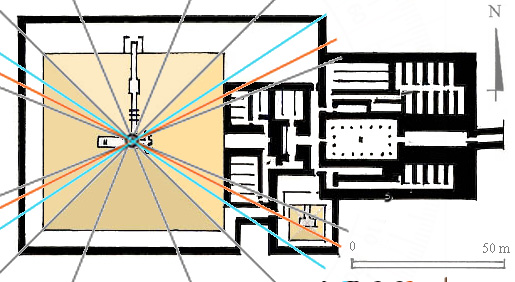
Hi,
i think the main point of divergance there is that what i suggest requires each pyramid to be it's own relative world centre as it were to the encircling horizon, rather than an ideogram of three Divinities or indeed in a relationship to other Royal pyramids.
Having said that other elements of the pyramid cult would be expected to extend and incorporate this relationship to the horizon.

edit on 28-5-2012 by Kantzveldt because: Add
Here's a neat little number trick which is a by-product of the frist diagram from the OP. If you have divided the angle between the solstice point
into 18 sectors along which the ecliptic plane is seen to progress over 6 months of the year, and then return to starting point, then your 1st point
will equate with the 36th, te 2nd with the 35th etc.
The numeric sum of the two decans that appear at these 18 rising points will thus always equal 37, and 18x37 will always equal 666
(to calculate the sum of integers of a number a method is to add 1 and multiply by half, eg the sum of integers of 36 is 18x37=666 )
In Egypt during the Old Kingdom the summer solstice saw the sun rise in conjunction with Regulus in Leo, as would periodically the moon, and curiously it was considered in 1705 that Regulus the sun and Moon in conjunction should be associated with the magic square of the sum of integers of 36;

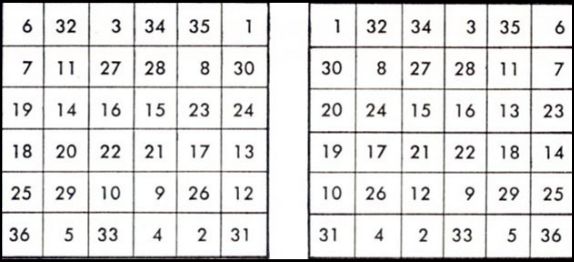
A hint then that the Masonic blazing star is Regulus, the pillars of sun and moon equating with a numeric system that divided the angle between the solstice points into 18 sectors.
The numeric sum of the two decans that appear at these 18 rising points will thus always equal 37, and 18x37 will always equal 666
(to calculate the sum of integers of a number a method is to add 1 and multiply by half, eg the sum of integers of 36 is 18x37=666 )
In Egypt during the Old Kingdom the summer solstice saw the sun rise in conjunction with Regulus in Leo, as would periodically the moon, and curiously it was considered in 1705 that Regulus the sun and Moon in conjunction should be associated with the magic square of the sum of integers of 36;


A hint then that the Masonic blazing star is Regulus, the pillars of sun and moon equating with a numeric system that divided the angle between the solstice points into 18 sectors.
I really enjoy your thread. There is a lot to take in and contemplate.
I think advanced mathematics are evident in structure at the very least in the ancient worlds.
Besides, the Library of Alexandria was burned to the ground four times.
Ceaser accidentally burned the library down around 40 B.C.
Then a war in the 3rd century burned it down again.
Then the pope at the end of the 4th century burned it, followed by the Muslim conquests in the 8th century. Our knowledge was burned and destroyed. What was left was carved into the earth's stone.
Perhaps this is where all the evidence of our historical knowledge with advanced mathematics went - up in flames.
S&F.
I think advanced mathematics are evident in structure at the very least in the ancient worlds.
Besides, the Library of Alexandria was burned to the ground four times.
Ceaser accidentally burned the library down around 40 B.C.
Then a war in the 3rd century burned it down again.
Then the pope at the end of the 4th century burned it, followed by the Muslim conquests in the 8th century. Our knowledge was burned and destroyed. What was left was carved into the earth's stone.
Perhaps this is where all the evidence of our historical knowledge with advanced mathematics went - up in flames.
S&F.
reply to post by CirqueDeTruth
Thanks, the Egyptians well observed that understanding the cosmological model led to an awareness and appreciation of order that lent itself to true establishment...within the greater scheme of things.
Thanks, the Egyptians well observed that understanding the cosmological model led to an awareness and appreciation of order that lent itself to true establishment...within the greater scheme of things.
reply to post by CirqueDeTruth
..but those who studied there for generations and had access to the Library don't mention this 'higher' mathematics.....
..but those who studied there for generations and had access to the Library don't mention this 'higher' mathematics.....
reply to post by Kantzveldt
S&F You should consider a career as an archeologist. Your creativity is needed in the world of linear history. I have often wondered if the fallen angels had their hand in ancient Egypt as founding all our ancient civilizations. We like to put everything in a nice neat box to feed the little people but the truth is.................far more interesting and mind blowing than what we will ever be told. Many discoveries are routinely purposely hidden and what cannot be hidden they provide a typically ridiculous theory.
S&F You should consider a career as an archeologist. Your creativity is needed in the world of linear history. I have often wondered if the fallen angels had their hand in ancient Egypt as founding all our ancient civilizations. We like to put everything in a nice neat box to feed the little people but the truth is.................far more interesting and mind blowing than what we will ever be told. Many discoveries are routinely purposely hidden and what cannot be hidden they provide a typically ridiculous theory.
new topics
-
Official denial
Diseases and Pandemics: 2 hours ago -
MEGA - Let's Make Europe Great Again
Other Current Events: 2 hours ago -
Hamas and Other Islamist Terrorist Groups Announce Support of US Campus Anti-Israel Protests
Education and Media: 3 hours ago -
Psychotronic Operation Rwanda Who Wants To Be A Refugee?
ATS Skunk Works: 3 hours ago -
AI phrenology
Science & Technology: 10 hours ago
top topics
-
4/27/24 New Jersey Earthquake
Fragile Earth: 16 hours ago, 8 flags -
AI phrenology
Science & Technology: 10 hours ago, 4 flags -
Psychotronic Operation Rwanda Who Wants To Be A Refugee?
ATS Skunk Works: 3 hours ago, 3 flags -
Hamas and Other Islamist Terrorist Groups Announce Support of US Campus Anti-Israel Protests
Education and Media: 3 hours ago, 3 flags -
Fun with extreme paints
Interesting Websites: 17 hours ago, 2 flags -
MEGA - Let's Make Europe Great Again
Other Current Events: 2 hours ago, 1 flags -
Official denial
Diseases and Pandemics: 2 hours ago, 0 flags
active topics
-
Canada caught red-handed manipulating live weather data and make it warmer
Fragile Earth • 27 • : Justoneman -
Psychotronic Operation Rwanda Who Wants To Be A Refugee?
ATS Skunk Works • 4 • : stonerwilliam -
Joe Biden Facing Criminal Charges In Ukraine
Mainstream News • 96 • : Justoneman -
What allies does Trump have in the world?
ATS Skunk Works • 7 • : Justoneman -
AI phrenology
Science & Technology • 15 • : Hecate666 -
MEGA - Let's Make Europe Great Again
Other Current Events • 8 • : watchitburn -
Official denial
Diseases and Pandemics • 4 • : Lochid -
-@TH3WH17ERABB17- -Q- ---TIME TO SHOW THE WORLD--- -Part- --44--
Dissecting Disinformation • 714 • : Justoneman -
Killings of Palestinian children are soaring in the West Bank.
World War Three • 163 • : Terpene -
Hamas and Other Islamist Terrorist Groups Announce Support of US Campus Anti-Israel Protests
Education and Media • 5 • : FlyersFan
13
